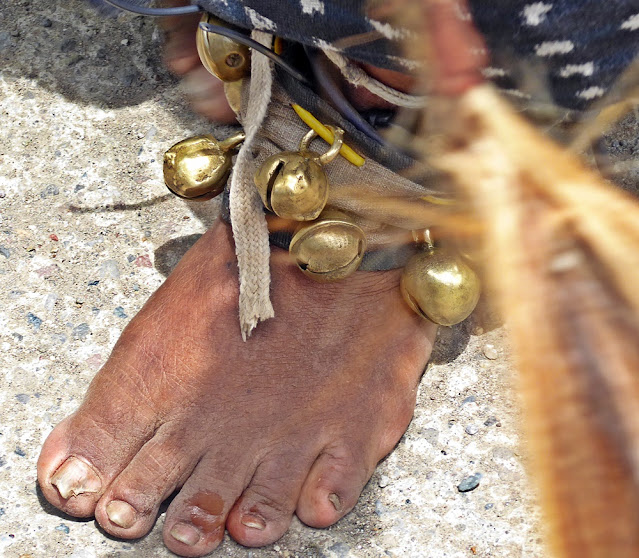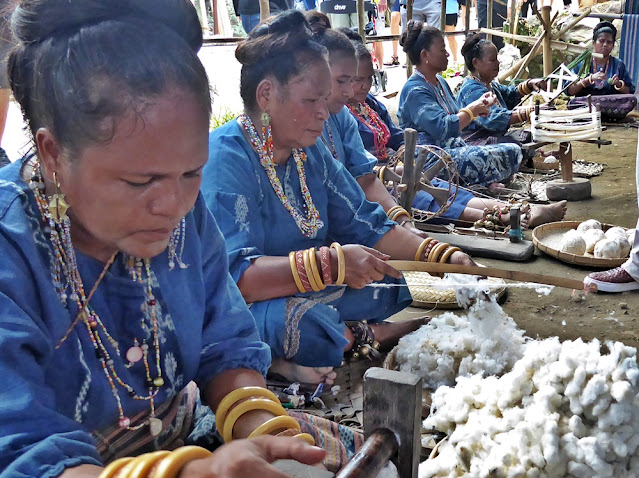Flores Island
Saturday, December 3, 2022
Flores Island
We’ve moved east to Flores Island, where more than 50,000 years ago an ancient human, Homo Floresiensis lived. These were tiny people, about three feet tall, and represent a different species from the Homo Sapiens (us). See: https://en.wikipedia.org/wiki/Homo_floresiensis We landed to visit the small community of Watublapi people in the village of Doka; they are known for their ikat weaving. They are extremely remote, deep into the jungle, and high up the side of a mountain.
We crammed 18 of us into each of these tiny buses, configured for people much smaller than we are. Most of the windows opened, but the 90+ degree temperature and probably 100% humidity made it extremely uncomfortable, and that was before we started. We drove about 30 minutes on a paved road along the coast and then turned inland, going up and up and up. The pavement gave out after about 10 minutes, but the drive up into the mountains took about 40 minutes, for a total time to get to the village of well over an hour. The road was full of potholes and stones, the going was slow, and the bus had lost its springs and shocks a long time ago. We finally got there.
As we got off the bus, two men were cooking snacks:
There was a welcome of the villagers:
Here's a video:
We were offered refreshments, including betel nuts, and,
having never chewed one, I took the opportunity.
We were told to chew and spit—not to swallow. Well, it’s extremely bitter, and I chewed for
a short while, found a spot to spit, and did so. My impression? Yuck.
And, I’d seen the result of long-time chewing:
There was music and dance, some of which sounded very Caribbean:
And a ceremony/dance on a tall pole which we didn’t understand:
Here's a video:
We then went to the weaving area where we saw the cotton
being spun into thread, hand dyed, and then woven:
It was a fascinating glimpse into a truly remote culture. The weaving cooperative in which the Watublapi participate collaborates with Fair Trade organizations and has been successful in selling their weavings all over the world. Joyce did buy a small purse:
Tomorrow is a sailing day with lectures. More then.















There's a big volcanic eruption in East Java, uncomfortably close to Bali - but fortunately you're sailing away from it.
ReplyDeleteReally interesting remote cultures, literally a world away from ours. The women's clothing is so colorful, wondering if it's all from their own weaving. Curious about their source of cotton and their dyes.
ReplyDeleteBeen meaning to ask you about crossing the equator, but it looks like that was in your air flt to Bali. I was thinking it might have been shipboard and was wondering if the had a Neptune ceremony! But probably not in an airplane. So everything is below the equator except for Singapore. How are the seas, shipboard life?
ReplyDelete"Bloody Mary's chewin' betel nuts / And she don't use Pepsodent" (from the Rodgers and Hammerstein musical "South Pacific").
ReplyDelete--I saw the same extreme tooth decay in New Orleans, on a guy who was hawking sticks of sugar cane to suck on. (Though his teeth weren't stained so darkly.) I bought a stick but didn't suck it very long, with that image in my head of what might result!
--It's amazing to see the local handcrafts in progress--quite lovely colors, imaginatively contrasted.
--The music with guitars sounded more Peruvian or Bolivian to me than Caribbean. But, yes, definitely Latin-American. I see in Wikipedia that the Banda islands were mainly colonized by the English and the Dutch, but Spanish sure seems the musical basis here!